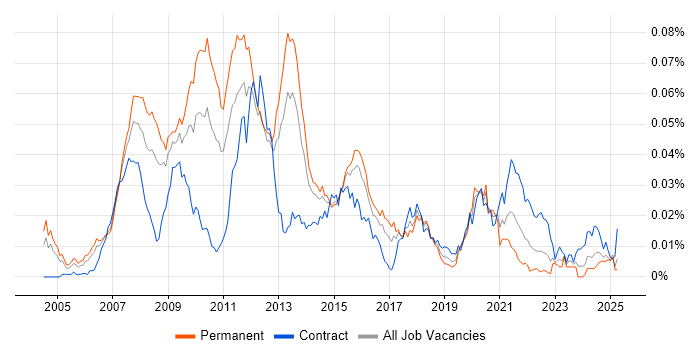Java Developer - Algo Trading
UK > England
The median Java Developer - Algo Trading salary in England is £125,000 per year, according to job vacancies posted during the 6 months leading to 12 December 2025.
The table below compares current salary benchmarking and summary statistics with the previous two years.
| 6 months to 12 Dec 2025 |
Same period 2024 | Same period 2023 | |
|---|---|---|---|
| Rank | 602 | 710 | - |
| Rank change year-on-year | +108 | - | - |
| Permanent jobs requiring a Java Developer - Algorithmic Trading | 10 | 4 | 0 |
| As % of all permanent jobs in England | 0.020% | 0.007% | - |
| As % of the Job Titles category | 0.023% | 0.008% | - |
| Number of salaries quoted | 10 | 4 | 0 |
| 10th Percentile | £105,000 | - | - |
| 25th Percentile | £116,250 | - | - |
| Median annual salary (50th Percentile) | £125,000 | £120,000 | - |
| Median % change year-on-year | +4.17% | - | - |
| 75th Percentile | £143,750 | - | - |
| 90th Percentile | £150,000 | - | - |
| UK median annual salary | £125,000 | £120,000 | - |
| % change year-on-year | +4.17% | - | - |
All Permanent IT Job Vacancies
England
For comparison with the information above, the following table provides summary statistics for all permanent IT job vacancies in England. Most job vacancies include a discernible job title that can be normalized. As such, the figures in the second row provide an indication of the number of permanent jobs in our overall sample.
| Permanent vacancies in England with a recognized job title | 44,402 | 52,240 | 42,852 |
| % of permanent jobs with a recognized job title | 90.21% | 93.83% | 95.12% |
| Number of salaries quoted | 28,028 | 29,074 | 33,507 |
| 10th Percentile | £28,250 | £32,500 | £32,000 |
| 25th Percentile | £36,250 | £43,750 | £43,750 |
| Median annual salary (50th Percentile) | £55,000 | £60,000 | £60,000 |
| Median % change year-on-year | -8.33% | - | - |
| 75th Percentile | £75,000 | £77,500 | £80,000 |
| 90th Percentile | £95,000 | £96,250 | £100,000 |
| UK median annual salary | £55,000 | £58,000 | £60,000 |
| % change year-on-year | -5.17% | -3.33% | - |
Java Developer - Algorithmic Trading
Job Vacancy Trend in England
Historical trend showing the proportion of permanent IT job postings featuring 'Java Developer - Algorithmic Trading' in the job title relative to all permanent IT jobs advertised in England.

Java Developer - Algorithmic Trading
Salary Trend in England
Salary distribution trend for Java Developer - Algorithmic Trading job vacancies in England.

Java Developer - Algorithmic Trading
Salary Histogram in England
Salary distribution for jobs citing Java Developer - Algorithmic Trading in England over the 6 months to 12 December 2025.
Java Developer - Algorithmic Trading
Job Locations in England
The table below looks at the demand and provides a guide to the median salaries quoted in IT jobs citing Java Developer - Algorithmic Trading within the England region over the 6 months to 12 December 2025. The 'Rank Change' column provides an indication of the change in demand within each location based on the same 6 month period last year.
| Location | Rank Change on Same Period Last Year |
Matching Permanent IT Job Ads |
Median Salary Past 6 Months |
Median Salary % Change on Same Period Last Year |
Live Jobs |
|---|---|---|---|---|---|
| London | +75 | 10 | £125,000 | +4.17% | |
| Java Developer - Algorithmic Trading UK |
|||||
Java Developer - Algorithmic Trading Skill Set
Top 30 Co-Occurring Skills & Capabilities in England
For the 6 months to 12 December 2025, Java Developer - Algorithmic Trading job roles required the following skills and capabilities in order of popularity. The figures indicate the absolute number of co-occurrences and as a proportion of all permanent job ads across the England region featuring Java Developer - Algorithmic Trading in the job title.
|
|
Java Developer - Algorithmic Trading Skill Set
Co-Occurring Skills & Capabilities in England by Category
The following tables expand on the one above by listing co-occurrences grouped by category. They cover the same employment type, locality and period, with up to 20 co-occurrences shown in each category:
